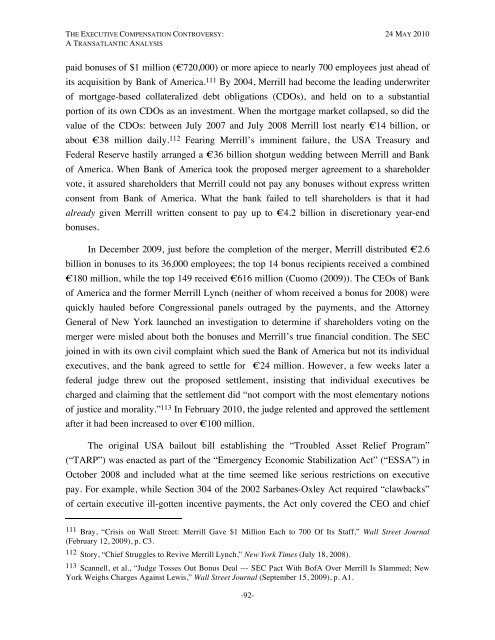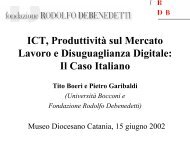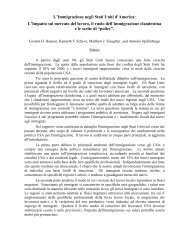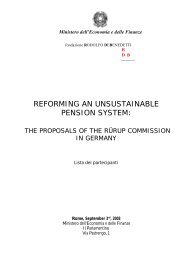The Executive Compensation Controversy - Fondazione Rodolfo ...
The Executive Compensation Controversy - Fondazione Rodolfo ...
The Executive Compensation Controversy - Fondazione Rodolfo ...
You also want an ePaper? Increase the reach of your titles
YUMPU automatically turns print PDFs into web optimized ePapers that Google loves.
THE EXECUTIVE COMPENSATION CONTROVERSY: 24 MAY 2010A TRANSATLANTIC ANALYSISpaid bonuses of $1 million (€720,000) or more apiece to nearly 700 employees just ahead ofits acquisition by Bank of America. 111 By 2004, Merrill had become the leading underwriterof mortgage-based collateralized debt obligations (CDOs), and held on to a substantialportion of its own CDOs as an investment. When the mortgage market collapsed, so did thevalue of the CDOs: between July 2007 and July 2008 Merrill lost nearly €14 billion, orabout €38 million daily. 112 Fearing Merrill’s imminent failure, the USA Treasury andFederal Reserve hastily arranged a €36 billion shotgun wedding between Merrill and Bankof America. When Bank of America took the proposed merger agreement to a shareholdervote, it assured shareholders that Merrill could not pay any bonuses without express writtenconsent from Bank of America. What the bank failed to tell shareholders is that it hadalready given Merrill written consent to pay up to €4.2 billion in discretionary year-endbonuses.In December 2009, just before the completion of the merger, Merrill distributed €2.6billion in bonuses to its 36,000 employees; the top 14 bonus recipients received a combined€180 million, while the top 149 received €616 million (Cuomo (2009)). <strong>The</strong> CEOs of Bankof America and the former Merrill Lynch (neither of whom received a bonus for 2008) werequickly hauled before Congressional panels outraged by the payments, and the AttorneyGeneral of New York launched an investigation to determine if shareholders voting on themerger were misled about both the bonuses and Merrill’s true financial condition. <strong>The</strong> SECjoined in with its own civil complaint which sued the Bank of America but not its individualexecutives, and the bank agreed to settle for €24 million. However, a few weeks later afederal judge threw out the proposed settlement, insisting that individual executives becharged and claiming that the settlement did “not comport with the most elementary notionsof justice and morality.” 113 In February 2010, the judge relented and approved the settlementafter it had been increased to over €100 million.<strong>The</strong> original USA bailout bill establishing the “Troubled Asset Relief Program”(“TARP”) was enacted as part of the “Emergency Economic Stabilization Act” (“ESSA”) inOctober 2008 and included what at the time seemed like serious restrictions on executivepay. For example, while Section 304 of the 2002 Sarbanes-Oxley Act required “clawbacks”of certain executive ill-gotten incentive payments, the Act only covered the CEO and chief111 Bray, “Crisis on Wall Street: Merrill Gave $1 Million Each to 700 Of Its Staff,” Wall Street Journal(February 12, 2009), p. C3.112 Story, “Chief Struggles to Revive Merrill Lynch,” New York Times (July 18, 2008).113 Scannell, et al., “Judge Tosses Out Bonus Deal --- SEC Pact With BofA Over Merrill Is Slammed; NewYork Weighs Charges Against Lewis,” Wall Street Journal (September 15, 2009), p. A1.-92-









